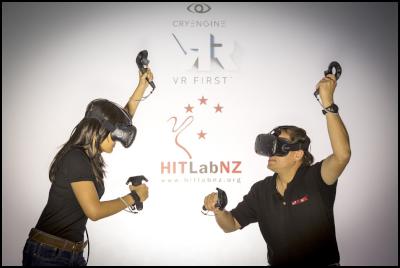Next-generation virtual reality tech for UC students
Next-generation virtual reality tech for UC students
Leading the way in next-generation virtual reality and motion capture technology, the Human-Interface Technology Lab (HIT Lab NZ) at the University of Canterbury (UC) has been named a founding site for the Crytek VR First initiative.

HIT Lab NZ PhD student Nikita Tuanquin (left) and UC Professor Rob Lindeman immersed in VR at the University of Canterbury.
UC’s HIT Lab NZ is the only institution in the Southern Hemisphere Crytek has selected for the initiative. The HIT Lab NZ and UC students will access leading virtual reality (VR) technology, including VR headsets from HTC, Sony, Samsung and Open Source VR. Motion-capture systems from Leap Motion, HTC and other manufacturers will also be available as part of the agreement.
Student developers and artists will have access to the incredibly realistic and robust Cryengine platform to roll out their next-generation immersive experiences. The HIT Lab NZ will provide space for the work to be done and foster a creative vibe among the participants, says UC Professor Rob Lindeman, Research Leader of the HIT Lab NZ.
The new technology will add to the already strong research infrastructure present at the HIT Lab NZ, including a VR CAVE, augmented reality headsets, full-body motion capture systems, wearable haptic systems, wind feedback systems, as well as a fabrication lab with 3D printers.
“We are so psyched to be part of this initial wave of the VR First initiative,” Prof Lindeman says.
“It allows us to combine our 20+ years of VR research with the leading providers of tools for realistic VR. There is so much call for people who really understand how to work with this new technology, and we are primed to educate the next generation of VR experience designers.”
More broadly, the VR First initiative at the HIT Lab NZ will embrace the creative community in Christchurch by providing access to the equipment to those outside UC to foster more collaboration between the University and Christchurch gaming communities.
“There is such a vibrant creative community in Christchurch. We hope that this initiative can help bring more focus to the region, and make it a destination for those wishing to be a part of creating engaging virtual experiences with impact,” Prof Lindeman says.
The HIT Lab NZ will share best practices and experiences with the other VR First sites which include the Vancouver Film School (Canada), School of Cinema Arts at the University of Southern California (USA), Rochester Institute of Technology (USA), Purdue University (USA), Carleton University (Canada), University of Florida (USA), California State University Monterey Bay (USA), Bahçeşehir University (Turkey), State University of New York at Oswego (USA), University College London (UK), Kajaanin Ammattikorkeakoulu University of Applied Sciences (Finland), and Manchester Metropolitan University (UK).
Established in 2003, the HIT Lab NZ focuses on supporting people in their everyday lives, at work, school, and play, through the application of human understanding and cutting-edge technology for virtual reality, augmented reality, gaming and human-robot interaction. The HIT Lab NZ offers Masters and PhD programmes in Human Interface Technology. Much of the work done at the HIT Lab is sponsored by local, national and international companies and organizations who tap into the HIT Lab’s expertise in advanced technology user experience design to help solve real world problems.
Established in 1999, Crytek has created multiple award-winning titles, including the original Far Cry, the Crysis series, Ryse: Son of Rome, andWarface.
ENDS


 Health Coalition Aotearoa: National Prevention Service Cuts - A Body-Blow To Health
Health Coalition Aotearoa: National Prevention Service Cuts - A Body-Blow To Health Queer Endurance in Defiance: Statement On The Proposed Restriction Of Puberty Blockers
Queer Endurance in Defiance: Statement On The Proposed Restriction Of Puberty Blockers NZ Olympic Committee: Nigel Avery Named NZ Team Chef de Mission For Glasgow 2026 Commonwealth Games And LA 2028 Olympic Games
NZ Olympic Committee: Nigel Avery Named NZ Team Chef de Mission For Glasgow 2026 Commonwealth Games And LA 2028 Olympic Games Education Review Office: ERO Calls For Reform Of NCEA Level 1
Education Review Office: ERO Calls For Reform Of NCEA Level 1 NZ Drug Foundation: Two New Studies Show A Concerning Increase In Drug Use And Availability
NZ Drug Foundation: Two New Studies Show A Concerning Increase In Drug Use And Availability Emirates Team NZ: Emirates Team New Zealand Ranked #5 In Global Sports Technology Power List
Emirates Team NZ: Emirates Team New Zealand Ranked #5 In Global Sports Technology Power List